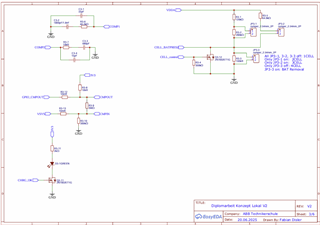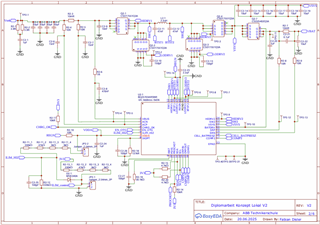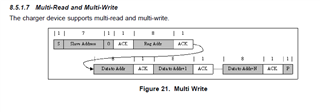Tool/software:
from smbus2 import SMBus
import time
import RPi.GPIO as GPIO
BQ25703A_I2C_ADDRESS = 0x6b
BQ25703A_MANUFACTURER_ID = 0x40
BQ25703A_DEVICE_ID = 0x78
MANUFACTURER_ID_ADDR = 0x2E
DEVICE_ID_ADDR = 0x2F
MAX_CHARGE_VOLTAGE_ADDR = 0x04
CHARGE_CURRENT_ADDR = 0x02
CHARGE_OPTION_0_ADDR = 0x00
MINIMUM_SYSTEM_VOLTAGE_ADDR = 0x0D
CHARGE_STATUS_ADDR = 0x20
ADC_OPTION_ADDR = 0x3A
VBUS_ADC_ADDR = 0x27
PSYS_ADC_ADDR = 0x26
VSYS_ADC_ADDR = 0x2D
VBAT_ADC_ADDR = 0x2C
ICHG_ADC_ADDR = 0x29
IDCHG_ADC_ADDR = 0x28
IIN_ADC_ADDR = 0x2B
EN_LWPWR = 0b0
EN_OOA = 0b1
CHARGING_ENABLED_MASK = 0b00000100
ADC_ENABLED_BITMASK = 0b01010111
ADC_START_CONVERSION_MASK = 0b01100000
ADC_CONT_CONVERSION_MASK = 0b10100000
#Max voltage register 1 values
MAX_VOLT_ADD_16384_MV = 0b01000000
MAX_VOLT_ADD_8192_MV = 0b00100000
MAX_VOLT_ADD_4096_MV = 0b00010000
MAX_VOLT_ADD_2048_MV = 0b00001000
MAX_VOLT_ADD_1024_MV = 0b00000100
MAX_VOLT_ADD_512_MV = 0b00000010
MAX_VOLT_ADD_256_MV = 0b00000001
#Max voltage register 2 values
MAX_VOLT_ADD_128_MV = 0b10000000
MAX_VOLT_ADD_64_MV = 0b01000000
MAX_VOLT_ADD_32_MV = 0b00100000
MAX_VOLT_ADD_16_MV = 0b00010000
#Minimum system voltage register values
MIN_VOLT_ADD_8192_MV = 0b00100000
MIN_VOLT_ADD_4096_MV = 0b00010000
MIN_VOLT_ADD_2048_MV = 0b00001000
MIN_VOLT_ADD_1024_MV = 0b00000100
MIN_VOLT_ADD_512_MV = 0b00000010
MIN_VOLT_ADD_256_MV = 0b00000001
VBUS_ADC_SCALE = 0.064
VBUS_ADC_OFFSET = 3.2
PSYS_ADC_SCALE = 0.012
VSYS_ADC_SCALE = 0.064
VSYS_ADC_OFFSET = 2.88
VBAT_ADC_SCALE = 0.064
VBAT_ADC_OFFSET = 2.88
ICHG_ADC_SCALE = 0.064
IIN_ADC_SCALE = 0.050
MAX_CHARGE_CURRENT = 8.128
MIN_CHARGE_CURRENT = 0.064
MAX_CURR_LSB_VAL_MA = 64
MAX_CHARGING_POWER = 60000
MAX_CURR_REG_SHIFT = 6
MAX_CURR_REG_03_MASK = 0b00011111
MAX_CURR_REG_02_MASK = 0b11000000
MAX_VSYS_VOLTAGE = 19.2
MAX_VOLT_LSB_VAL_MV = 16
MAX_VOLT_REG_SHIFT = 4
MAX_VOLT_REG_05_MASK = 0b01111111
MAX_VOLT_REG_04_MASK = 0b11110000
VSYS_MIN_MV = 1024
VSYS_MIN_LSB_MV = 256
class bq25703a:
i2c_address = BQ25703A_I2C_ADDRESS
i2c_bus = 1
ilim_hiz_pin = 21
connected = 0
charging_status = 0
vbat_voltage = 0
vbus_voltage = 0
vsys_voltage = 0
input_current = 0
charge_current = 0
max_charge_current_ma = 0
def __init__(self, bus = i2c_bus, address = i2c_address, ilim_hiz_pin = ilim_hiz_pin):
self.i2c_bus = bus
self.i2c_address = address
self.ilim_hiz_pin = ilim_hiz_pin
print("Starting bq25703a Interface on I2C bus " + str(self.i2c_bus) + " with address " + str(hex(self.i2c_address)))
GPIO.setmode(GPIO.BCM)
GPIO.setup(self.ilim_hiz_pin, GPIO.OUT)
GPIO.output(self.ilim_hiz_pin, 0)
try:
with SMBus(self.i2c_bus) as smbus:
# Get the manufacturer id
manufacturer_id = smbus.read_byte_data(self.i2c_address, MANUFACTURER_ID_ADDR)
# Get the device id
device_id = smbus.read_byte_data(self.i2c_address, DEVICE_ID_ADDR)
# Set the ADC Options
smbus.write_byte_data(self.i2c_address, ADC_OPTION_ADDR, ADC_ENABLED_BITMASK)
charge_option_0_register_1_value = 0b00100110
smbus.write_byte_data(self.i2c_address, CHARGE_OPTION_0_ADDR + 1, charge_option_0_register_1_value)
charge_option_0_register_2_value = 0b00001110
smbus.write_byte_data(self.i2c_address, CHARGE_OPTION_0_ADDR, charge_option_0_register_2_value)
except:
manufacturer_id = 0
device_id = 0
if ((device_id == BQ25703A_DEVICE_ID) and (manufacturer_id == BQ25703A_MANUFACTURER_ID)):
self.connected = 1
print("bq25703a connected")
else:
self.connected = 0
print("bq25703a not found!")
# @brief Returns whether the regulator is charging
# @retval uint8_t 1 if charging, 0 if not charging
def Get_Regulator_Charging_State(self):
with SMBus(self.i2c_bus) as smbus:
data = smbus.read_byte_data(self.i2c_address, CHARGE_STATUS_ADDR)
if (data and CHARGING_ENABLED_MASK):
self.charging_status = 1
else:
self.charging_status = 0
return self.charging_status
def Set_Charge_Voltage(self, voltage):
round(voltage, 3)
if (voltage > MAX_VSYS_VOLTAGE):
voltage = MAX_VSYS_VOLTAGE
if (voltage < (VSYS_MIN_MV/1000)):
voltage = (VSYS_MIN_MV/1000)
#convert to mV
voltage = int(voltage * 1000)
#Make sure the value is divisiable by 16mV
while ((int(voltage) % MAX_VOLT_LSB_VAL_MV) != 0):
#increment down until voltage is divisiable by 16mV
voltage = voltage - 1
minimum_system_voltage_value = voltage - 5000
while ((minimum_system_voltage_value % VSYS_MIN_LSB_MV) != 0):
#increment down until minimum_system_voltage_value is divisiable by VSYS_MIN_LSB_MV
minimum_system_voltage_value = minimum_system_voltage_value - 1
if (minimum_system_voltage_value < VSYS_MIN_MV):
minimum_system_voltage_value = VSYS_MIN_MV
minimum_system_voltage_value = minimum_system_voltage_value / VSYS_MIN_LSB_MV
voltage = voltage / MAX_VOLT_LSB_VAL_MV
voltage_list = [((int(voltage) << 4) & MAX_VOLT_REG_04_MASK), ((int(voltage) >> 4) & MAX_VOLT_REG_05_MASK)]
with SMBus(self.i2c_bus) as smbus:
smbus.write_byte_data(self.i2c_address, MINIMUM_SYSTEM_VOLTAGE_ADDR, int(minimum_system_voltage_value))
smbus.write_i2c_block_data(self.i2c_address, MAX_CHARGE_VOLTAGE_ADDR, voltage_list)
def Set_Charge_Current(self, current):
current = float(current)
round(current, 3)
if (current > MAX_CHARGE_CURRENT):
current = MAX_CHARGE_CURRENT
if (current < MIN_CHARGE_CURRENT):
current = MIN_CHARGE_CURRENT
#convert to mA
current = int(current * 1000)
self.max_charge_current_ma = current
#Make sure the value is divisiable 64mA
while ((int(current) % MAX_CURR_LSB_VAL_MA) != 0):
#increment down until current is divisiable by 64mA
current = current - 1
current = current / MAX_CURR_LSB_VAL_MA
current_list = [((int(current) << 6) & MAX_CURR_REG_02_MASK), ((int(current) >> 2) & MAX_CURR_REG_03_MASK)]
with SMBus(self.i2c_bus) as smbus:
smbus.write_i2c_block_data(self.i2c_address, CHARGE_CURRENT_ADDR, current_list)
GPIO.output(self.ilim_hiz_pin, 1)
def Read_Charger_Status(self):
with SMBus(self.i2c_bus) as smbus:
data = smbus.read_byte_data(self.i2c_address, CHARGE_STATUS_ADDR + 1)
print("Charge Status Address 0x21 = " + str(bin(data)))
data = smbus.read_byte_data(self.i2c_address, CHARGE_STATUS_ADDR)
print("Charge Status Address 0x20 = " + str(bin(data)))
# @brief Gets VBAT voltage that was read in from the ADC on the regulator
# @retval VBAT voltage in volts
def Get_VBAT_ADC_Reading(self):
self.__read_adc()
return self.vbat_voltage
# @brief Gets VBUS voltage that was read in from the ADC on the regulator
# @retval VBUS voltage in volts
def Get_VBUS_ADC_Reading(self):
self.__read_adc()
return self.vbus_voltage
# @brief Gets Input Current that was read in from the ADC on the regulator
# @retval Input Current in amps
def Get_Input_Current_ADC_Reading(self):
self.__read_adc()
return self.input_current
# @brief Gets Charge Current that was read in from the ADC on the regulator
# @retval Charge Current in amps
def Get_Charge_Current_ADC_Reading(self):
self.__read_adc()
return self.charge_current
# @brief Gets the max output current for charging
# @retval Max Charge Current in miliamps
def Get_Max_Charge_Current(self):
self.__read_adc()
return self.max_charge_current_ma
def __read_adc(self):
with SMBus(self.i2c_bus) as smbus:
# Perform single conversion
smbus.write_byte_data(self.i2c_address, (ADC_OPTION_ADDR+1), ADC_START_CONVERSION_MASK)
conversion_finished = 0
while (conversion_finished == 0):
data = smbus.read_byte_data(self.i2c_address, (ADC_OPTION_ADDR+1))
conversion_finished = (data and (1<<6))
time.sleep(0.05)
data = smbus.read_byte_data(self.i2c_address, VBAT_ADC_ADDR)
self.vbat_voltage = (data * VBAT_ADC_SCALE) + VBAT_ADC_OFFSET
data = smbus.read_byte_data(self.i2c_address, VSYS_ADC_ADDR)
self.vsys_voltage = (data * VSYS_ADC_SCALE) + VSYS_ADC_OFFSET
data = smbus.read_byte_data(self.i2c_address, ICHG_ADC_ADDR)
self.charge_current = data * ICHG_ADC_SCALE
data = smbus.read_byte_data(self.i2c_address, IIN_ADC_ADDR)
self.input_current = data * IIN_ADC_SCALE
data = smbus.read_byte_data(self.i2c_address, VBUS_ADC_ADDR)
self.vbus_voltage = (data * VBUS_ADC_SCALE) + VBUS_ADC_OFFSET
def check_hidrv1_activation(self):
with SMBus(self.i2c_bus) as smbus:
# Lese Charge Status Register (Adresse kann je nach Chip variieren)
status = smbus.read_byte_data(self.i2c_address, CHARGE_STATUS_ADDR)
print(f"Charge Status Register: {bin(status)}")
# Überprüfe, ob das System im Hi-Z-Modus ist
adc_option = smbus.read_byte_data(self.i2c_address, ADC_OPTION_ADDR)
print(f"ADC Option Register: {bin(adc_option)}")
def read_register_20h(self):
with SMBus(self.i2c_bus) as smbus:
register_address = 0x20
wert = smbus.read_byte_data(self.i2c_address, register_address)
print(f"Register 0x20: {hex(wert)}")
return wert
if __name__ == "__main__":
# Instanz erstellen
device = bq25703a()
# Überprüfen, ob das Gerät verbunden ist
if device.connected:
print("Gerät ist verbunden.")
while True:
# Ladezustand abfragen
charging_state = device.Get_Regulator_Charging_State()
print(f"Ladevorgang läuft: {'Ja' if charging_state else 'Nein'}")
# Batterienspannung und Versorgungsspannungen auslesen
vbat = device.Get_VBAT_ADC_Reading()
vbus = device.Get_VBUS_ADC_Reading()
print(f"VBAT: {vbat:.3f} V")
print(f"VBUS: {vbus:.3f} V")
# Eingabestrom auslesen
input_current = device.Get_Input_Current_ADC_Reading()
print(f"Eingangsstrom: {input_current:.3f} A")
# Ladestrom und Max. Ladestrom auslesen
charge_current = device.Get_Charge_Current_ADC_Reading()
max_charge_current = device.Get_Max_Charge_Current()
print(f"Ladestrom: {charge_current:.3f} A")
print(f"Max. Ladestrom: {max_charge_current:.1f} mA")
# Beispiel: Ladespannung auf 4,2 V setzen
device.Set_Charge_Voltage(4.2)
print("Ladespannung auf 4,2 V gesetzt.")
# Beispiel: Ladestrom auf 2 A setzen
device.Set_Charge_Current(2)
print("Ladestrom auf 2 A gesetzt.")
# Optional: Lade-Status auslesen
device.Read_Charger_Status()
device.check_hidrv1_activation()
device.read_register_20h()
print("----------------------------------------------------------------")
time.sleep(3)
else:
print("Gerät nicht verbunden.")


Dear Texas Instruments Support Team,
I am a student from Switzerland and for my thesis I am currently working with a BQ25703A
I am trying to operate my system without a battery connected, primarily for testing purposes.
Problem:
I am seeing a voltage drop across MOSFET Q2-1, which is driven by HIDRV1. I have 5.2V before the MOSFET, but only 1.3V after it. This indicates that the MOSFET is blocking the voltage.
A schematic of my setup is attached for your reference.
Question:
What configuration settings are necessary to allow the voltage to pass through Q2-1 and reach VSYS, enabling system operation without a battery? Which registers and bits control this?
Goal: I want to power the system connected to VSYS from the input source even with no battery.
The CELL_BATPRESZ pin is currently Permanently tied LOW.
Future Intention:
I also plan to use the BQ25703A with a 4-cell battery pack in the future. Is the attached code snippet suitable for a 4-cell configuration, or will register values need to be changed?
I have attached a snippet of my current initialization code below:
I would appreciate any guidance you can provide to resolve this voltage blocking issue and ensure proper system operation without a battery.
Thank you for your time and expertise.
Sincerely,
Fabian


